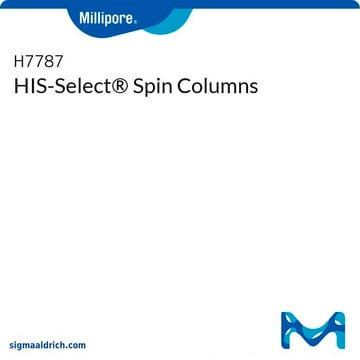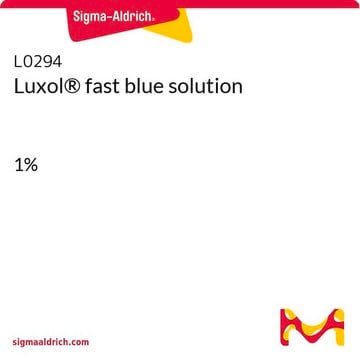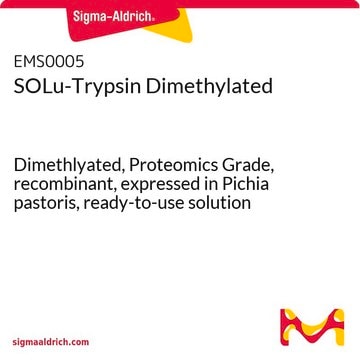TT0010
Trypsin Spin Columns
for proteomics
Synonym(s):
Immobilized TPCK- treated Trypsin, Immobilized Trypsin
Sign Into View Organizational & Contract Pricing
All Photos(1)
About This Item
UNSPSC Code:
12352200
NACRES:
NA.56
Recommended Products
grade
for proteomics
storage temp.
2-8°C
Looking for similar products? Visit Product Comparison Guide
Related Categories
General description
Enjoy all of the advantages of Proteomics Grade Trypsin in a 15-minute digestion. A staple of MS sample preparation, efficient tryptic digestion is essential to successful proteomic analyses. While traditional digests require up to 18 hours, the same digest can be accomplished in only 15 minutes using the Trypsin Spin Column, Proteomics Grade.
This ultra-micro spin column contains highly purified, TPCK-treated porcine trypsin immobilized on a spherical 20 micron silica support, chemically modified to minimize non-specific adsorption. This product is ideal for rapid protein digestion of small volumes (100 μl or less). Eluted peptides are ready for MS analysis, and require no additional clean-up.
This ultra-micro spin column contains highly purified, TPCK-treated porcine trypsin immobilized on a spherical 20 micron silica support, chemically modified to minimize non-specific adsorption. This product is ideal for rapid protein digestion of small volumes (100 μl or less). Eluted peptides are ready for MS analysis, and require no additional clean-up.
Features and Benefits
Discover the advantages for yourself!
- 15 minute digestion
- Ideal for 10 to 100 μg of protein sample
- Minimal chymotryptic activity
- No additional clean-up required
related product
Product No.
Description
Pricing
Signal Word
Warning
Hazard Statements
Precautionary Statements
Hazard Classifications
Acute Tox. 4 Oral
Storage Class Code
10 - Combustible liquids
Flash Point(F)
Not applicable
Flash Point(C)
Not applicable
Certificates of Analysis (COA)
Search for Certificates of Analysis (COA) by entering the products Lot/Batch Number. Lot and Batch Numbers can be found on a product’s label following the words ‘Lot’ or ‘Batch’.
Already Own This Product?
Find documentation for the products that you have recently purchased in the Document Library.
Customers Also Viewed
Logan J Everett et al.
Journal of proteome research, 9(2), 700-707 (2009-12-02)
"Multi-stage" search strategies have become widely accepted for peptide identification and are implemented in a number of available software packages. We describe limitations of these strategies for validation and decoy-based statistical analyses and demonstrate these limitations using a set of
Hans W Hahn et al.
Journal of proteome research, 8(9), 4225-4230 (2009-07-31)
Trypsin was immobilized on glycidylmethacrylate-co-divinylbenzene (GMA/DVB) polymerized in pipet tips for online enzymatic digestion of proteins. The major advantages of in-tip digestion are easy handling and small sample amount required for analysis. Microwave-assisted digestion was applied for highly efficient and
Julianne Backiel et al.
Biochemistry, 47(43), 11273-11284 (2008-10-04)
Enzymes of the Rnf family are believed to be bacterial redox-driven ion pumps, coupling an oxidoreduction process to the translocation of Na+ across the cell membrane. Here we show for the first time that Rnf is a flavoprotein, with FMN
Tomoharu Takeuchi et al.
Biological & pharmaceutical bulletin, 34(7), 1139-1142 (2011-07-02)
To study the endogenous counterpart of LEC-6, a major galectin in Caenorhabditis elegans, the proteomic analysis of glycoproteins captured by an immobilized LEC-6 column was performed using the nano liquid chromatography-tandem mass spectrometry (LC-MS/MS) technique. A protein recovered in a
Jiangjiang Liu et al.
Journal of the American Society for Mass Spectrometry, 20(5), 819-828 (2009-02-10)
This work uses electrospray ionization mass spectrometry (ESI-MS) in conjunction with hydrogen/deuterium exchange (HDX) and optical spectroscopy for characterizing the solution-phase properties of cytochrome c (cyt c) after heat exposure. Previous work demonstrated that heating results in irreversible denaturation for
Our team of scientists has experience in all areas of research including Life Science, Material Science, Chemical Synthesis, Chromatography, Analytical and many others.
Contact Technical Service














